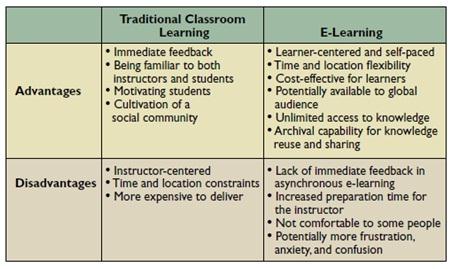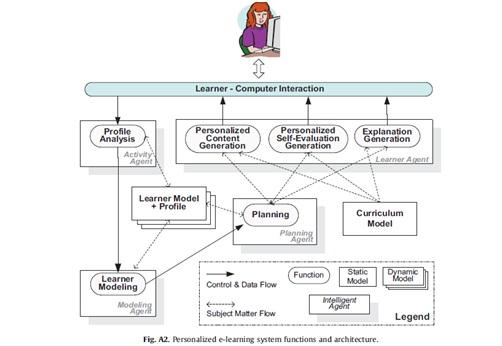- Articles ›
- Human Resources ›
- Cost Benefit Analysis of E-Learning in Organizations Articles
Cost Benefit Analysis of E-Learning in Organizations
With advent of technology, e-learning has rapidly grown from being just another term or concept into a hard reality in many organizations in various forms – be it online learning, computer-mediated learning, blended learning, web-based learning, or mobile learning and they all have one thing in common, i.e. ability to use a computer connected to a network. E-learning is a concept that helps learners learn from the learning materials from anywhere, at any time and any liked pace in which they want to learn. It is a form of social learning focused at answering the needs of the student / learner.

Image Courtesy: freedigitalphotos.net, KROMKRATHOG
It is a tool supported by latest technology to make the learning process more flexible, innovative, learner-centered (Demiray 2010, Ozuorcun & Tabak 2012). It is a special method of collaborative learning process conducted online through internet technology where the teacher and the student are not required to be present at the same place at the same time (Yucel 2006).

(Source: Dongsong Zhang et al. (2004): Can E-Learning replace Classroom learning?, Communications of ACM, Vol. 47, No. 5, pp 75-79)
SWOT ANALYSIS OF E-LEARNING SERVICES FROM BENEFICIARY PERSPECTIVE
This section focuses on the various strengths and weaknesses of e-learning and then try to find out the opportunities and threats for the same.
Strengths:
It allows a lot of flexibility (Brown & Charlier 2012, Dobre 2010, Hsieh & Cho 2011), accessibility in terms of geographical independence and thus a lot of coverage without substantial cost for traditional classroom training. It gives options to customize and tailor-make the learning materials as per the needs of the individual learners (Clark & Mayer 2008). It offers great deal of diversity in terms of versatile package of methods, content, processes, techniques, etc. With the ability to integrate text, visuals, audio, graphics, animation, simulations etc it helps to make the curriculum easy to imbibe which otherwise would be too dull to read from traditional text books. This also facilitates quick understanding of the concepts by not just going through the theory but also see the demonstrations. By involving the participants to give quick feedback, complete tasks through simulations, take formative assessments online, it helps students gain confidence and motivation to learn (Solc et al., 2012). It also helps reduce stress by 50% by allowing the student to learn without a teacher and increases overall performance of the learner (Demiray 2010). The main focus of e-learning is to facilitate continuous learning process and method of teaching the learners using superior techniques assisted by technology rather than deciding on the content to be taught (Clark & Mayer 2011).
Weaknesses:
E-learning has an insufficient capability to link technological design of the training services with that of the psychological component of the learning process as opposed to that in any traditional classroom training (Clark & Mayer 2008, 2011). Too much of flexibility and autonomy in the learning process might prove otherwise in terms of the actual learning for the learner and this is completely unnoticed by the training designer or the trainer (Cook 2007). Though there is lot of customization in terms of the learning methodology but might not be all the needs of different individual learners are always met and due to lack of a physical trainer remains unaddressed (Cook 2007). This training can develop digital competence through wide variety of methodology, tools, and processes but might lack in creating academic skills (CCL 2009). The interaction between the trainer and the trainee is very limited and thus poses chances of lack of collaboration, communication and mutual knowledge sharing (CCL 2009).
Opportunities:
With expansion of technology the current shortfalls of e-learning can be overcome and we can have perfect environment for expression and development of such courses (Liebowitz 2011). Apart from the basic education, multiple other administrative activities like enrollment, evaluation, feedback collection, result generation etc can be handled through the same shared technological platform (Demiray 2010). Clark and Mayer (2008, 2011) have pointed out the positive increase in market share for digital learning as against traditional training. Relative lower cost and reuse of content for e-learning courses and reduced distribution cost has huge financial implications for large organization and often help in centralization of the training initiatives (Wu et al. 2012, CCl 2009).
Threats:
Exaggerated positive role of technology often creates huge risk of ignoring student and the monitoring the actual learning as opposed to that in traditional training (Liebowitz and Frank, 2011). Multiple studies also point out the lack of motivation by teachers in engaging in e-learning and its support by creating e-learning materials and implementing them (Demiray 2010). The flexibility and autonomy of the learner often does not guarantee their performance in learning and results in higher drop-outs (Dobre 2010). In fact this is more because of lack of face-to-face monitoring and active involvement by the teachers to ensure the actual learning intended. Even though once created maintenance of e-learning materials is quite cheap (Dobre 2010) but the initial investment in setting up new technology to facilitate e-learning, human resource training in using them, design and development of the courses, etc are quite high and might act as deterrent in transformation from traditional to e-learning approaches (Cook 2007). Last but not the least is the lack of government policies and legislation regarding courses and e-learning contents adds to lack of quality standards and quality controls and standardization of e-content production and delivery mechanisms resulting in varying impacts of e-learning in different organizations in differing contexts (Demiray 2010).
LEARNING MANAGEMENT SYSTEMS & E-LEARNING EFFECTIVENESS
When it comes to implementing e-learning corporates often take help of Learning Management Systems (LMS) for giving corporate training to their workforce. LMS is a web-based system that facilitates sharing of instructional materials, class announcements, exchange of course assignments and online communication between the trainees and the trainers. Even though LMS can be leveraged for evolving newer learning practices and innovative teaching methods, however in most of the companies LMS is mostly used for distribution, management and retrieval of course material only for self-learning by the employees. LMS can be used to facilitates self-reflection and promote active learning (Herse & Lee 2005). According to West et al. (2007), once the trainers get familiar with technology they start using LMs for its more interactive features and this leads active learning by participants as opposed to passive learning.
Multiple research shows that the two major reasons for which corporates go for e-learning instead of traditional training methods are:
1. The Cost Advantages – e-learning saves lots of cash by reducing training time, costs saved in travel and time away from job, its scalability to serve large number of participants at one go with little additional costs.
2. The Flexibility in Training – e-learning can cater to flexible delivery of content to ensure consistent learning experience across all times and all places. This gives a great leverage in case of geographically dispersed workforce. Not only this, e-learning also facilitates self-paced learning for the employees giving them great opportunity to balance their work as well as the training needs given that employees are self-motivated and comfortable with self-instructions.

(Source: Dongming Xu, Wayne W. Huang, Huaiqing Wangd, Jon Heales (2014): “Enhancing e-learning effectiveness using an intelligent agent-supported personalized virtual learning environment: An empirical investigation”, Information & Management, Vol-51, pp. 430-440)
Derouin, Fritche and Salas (2005) had tried to evaluate how e-learning is being used by companies / organizations for their employee development. The observations are listed below:
a. Organizations have increasingly used e-learning to teach Information Technology, Business and Soft Skills to their employees.
b. E-learning has been deployed to give greater control to employees over their learning requirements.
c. Organizations have developed better ways to enhance collaboration, customization and personalization which helped them engage the learners.
d. To reap maximum benefits, organizations have combined e-learning with other training media like instructor-led seminars, live coaching, etc moving more towards “blended learning”.
e. Training programs implement “rapid e-learning” i.e. faster training development in terms of quick design of programs in cost-effective manner.
f. Organize also personalize and customize e-learning as per employee preferences to facilitate the learning process and environment.
While discussing about ways to measure the effectiveness or ROI of e-learning, it follows the same traditional four step Kirkpatrick Model (1979) or the more evolved 5-step Philips Model (1996). Based on all the above ways of evaluation, firms praise e-learning as the most cost-effective, convenient and effective way to deliver corporate training for their workforce (Strother 2002).
CONCLUSION
In past few years e-learning has emerged as an effective tool for life-long learning as well as on the job training. The latest innovation in the field of IT presents us with opportunities for both technological breakthroughs as well as theoretical advancement in e-learning and make it more effective for employee development. E-learning is the future of academic as well as professional education and we need to continuously explore possibilities of creating more appealing and effective online learning environments through greater personalization, enhanced system interactivity etc all leading to better engaged learners.
This article has been authored by Anirban Ghosh from XLRI
REFERENCES
Canadian Council on Learning. (2009). State of E-learning in Canada. Ottawa, Ontario. Retrieved from http://www.ccl-cca.ca/pdfs/E-learning/ELearning_Report_FINAL-E.PDF.
Cook, D. A. (2007). Web-based learning: pros, cons and controversies. Clinical Medicine, Journal of the Royal College of Physicians, 7(1), 37-42.
Demiray, U. (2010). e-LEARNING practices, Cases on challenges facing e-learning and national development: Institutional Studies and Practices, VOLUME: I, Anadolu University, Eskisehir-Turkey.
Demiray, U. (2010). e-LEARNING practices, Cases on challenges facing e-learning and national development: Institutional Studies and Practices, VOLUME: II, Anadolu University, Eskisehir-Turkey.
Dobre, I. (2010). Studiu critic al actualelor sisteme de e-learning, Academia Română, Institutul de cercetări pentru inteligenţă artificială: Bucureşti.
Dongming Xu, Wayne W. Huang, Huaiqing Wangd, Jon Heales (2014): “Enhancing e-learning effectiveness using an intelligent agent-supported personalized virtual learning environment: An empirical investigation”, Information & Management, Vol-51, pp. 430-440
Dongsong Zhang et al. (2004): Can E-Learning replace Classroom learning?, Communications of ACM, Vol. 47, No. 5, pp 75-79.
Herse, P., & Lee, A. (2005). Optometry and WebCT: A student survey of the value of web-based learning environments in optometric education. Clinical and Experimental Optometry, 88(1), 46–52
Hsieh, P.-A. J., & Cho, V. (2011). Comparing e-Learning tools’ success: The case of instructor–student interactive vs. self-paced tools. Computers & Education, 57(3), 2025–2038.
Kirkpatrick, D. (1979). Techniques for evaluating training programs. Training and Development Journal. 33(6), p. 78-92.
APPENDIX - INTERESTING FACTS ABOUT “E-LEARNING AND ITS POWER”
1. 41.7% of Global Fortune 500 companies used technology to facilitate learning during last year. Companies plan to invest 240% more into e-learning in 2013. (Source: Elearning! Magazine, May 2013) http://elmezine.epubxp.com/title/55545/28)
2. E-Learning led to 60% faster learning curve as compared to instructor-led training (Source: Facts, Figures and Forces Behind e-Learning, August 2000)
http://learnframe.com/aboutelearning/elearningfacts.pdf
3. IBM found that with e-learning, participants learned nearly five times more material without increasing time spent in training (Source: Article: eLearning Success – measuring ROI impact and benefits, May 2013)
http://www.theinformationdaily.com/2013/05/10/e-learning-success-measuring-the-roi-impact-and-benefits
4. Companies employing training and development through eLearning best practices have generated 26% higher revenues per employee (Source: The Business Impact of Next-Generation eLearning, 2011)
http://wwwimages.adobe.com/www.adobe.com/content/dam/Adobe/en/products/adobeconnect/pdfs/elearning/092111-rr-nextgen-elearning-ba-ctcrevised-vendor.pdf
Views expressed in the article are personal. The articles are for educational & academic purpose only, and have been uploaded by the MBA Skool Team.
If you are interested in writing articles for us, Submit Here
Share this Page on:
What is MBA Skool?About Us
MBA Skool is a Knowledge Resource for Management Students, Aspirants & Professionals.
Business Courses
Quizzes & Skills
Quizzes test your expertise in business and Skill tests evaluate your management traits
All Business Sections
Write for Us